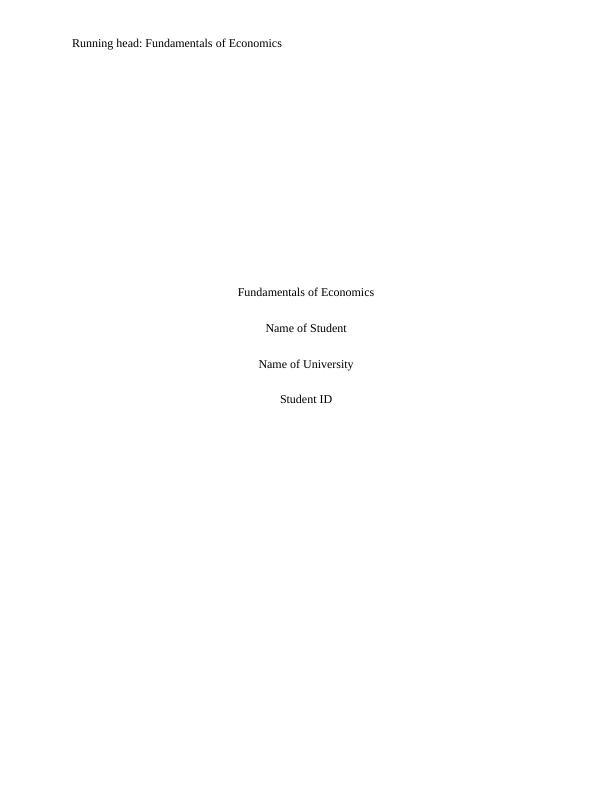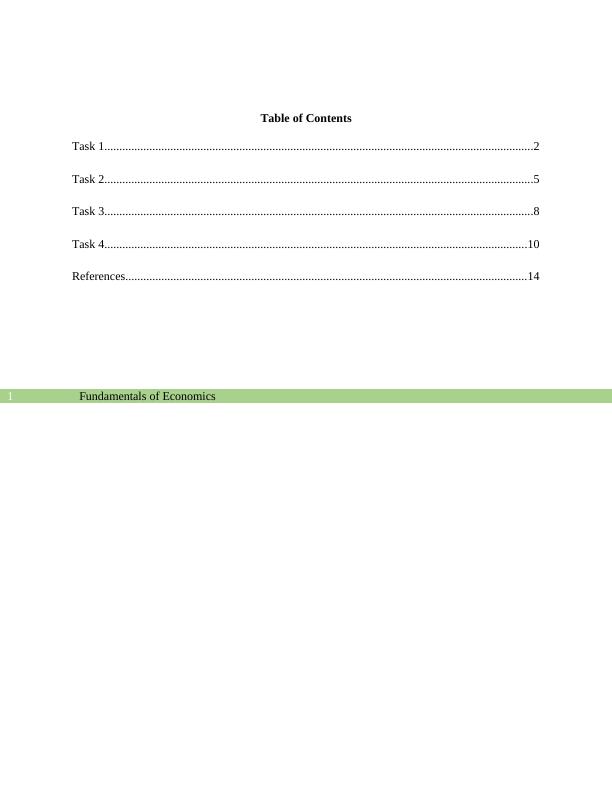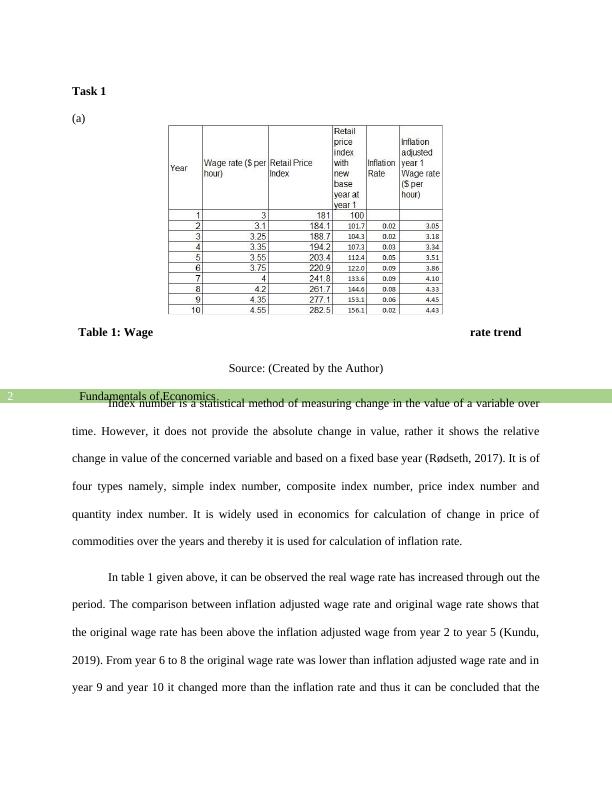Fundamentals of Economics.
Added on 2022-10-01
19 Pages4100 Words5 Views
Running head: Fundamentals of Economics
Fundamentals of Economics
Name of Student
Name of University
Student ID
Fundamentals of Economics
Name of Student
Name of University
Student ID

Fundamentals of Economics1
Table of Contents
Task 1...............................................................................................................................................2
Task 2...............................................................................................................................................5
Task 3...............................................................................................................................................8
Task 4.............................................................................................................................................10
References......................................................................................................................................14
Table of Contents
Task 1...............................................................................................................................................2
Task 2...............................................................................................................................................5
Task 3...............................................................................................................................................8
Task 4.............................................................................................................................................10
References......................................................................................................................................14

Fundamentals of Economics2
Task 1
(a)
Table 1: Wage rate trend
Source: (Created by the Author)
Index number is a statistical method of measuring change in the value of a variable over
time. However, it does not provide the absolute change in value, rather it shows the relative
change in value of the concerned variable and based on a fixed base year (Rødseth, 2017). It is of
four types namely, simple index number, composite index number, price index number and
quantity index number. It is widely used in economics for calculation of change in price of
commodities over the years and thereby it is used for calculation of inflation rate.
In table 1 given above, it can be observed the real wage rate has increased through out the
period. The comparison between inflation adjusted wage rate and original wage rate shows that
the original wage rate has been above the inflation adjusted wage from year 2 to year 5 (Kundu,
2019). From year 6 to 8 the original wage rate was lower than inflation adjusted wage rate and in
year 9 and year 10 it changed more than the inflation rate and thus it can be concluded that the
Task 1
(a)
Table 1: Wage rate trend
Source: (Created by the Author)
Index number is a statistical method of measuring change in the value of a variable over
time. However, it does not provide the absolute change in value, rather it shows the relative
change in value of the concerned variable and based on a fixed base year (Rødseth, 2017). It is of
four types namely, simple index number, composite index number, price index number and
quantity index number. It is widely used in economics for calculation of change in price of
commodities over the years and thereby it is used for calculation of inflation rate.
In table 1 given above, it can be observed the real wage rate has increased through out the
period. The comparison between inflation adjusted wage rate and original wage rate shows that
the original wage rate has been above the inflation adjusted wage from year 2 to year 5 (Kundu,
2019). From year 6 to 8 the original wage rate was lower than inflation adjusted wage rate and in
year 9 and year 10 it changed more than the inflation rate and thus it can be concluded that the

Fundamentals of Economics3
real wage was lower in 6th, 7th, and 8th years than it should be to afford the same amount of goods
and services that a worker could afford in the previous year. In case of the rest of the years real
wage rate has increased.
(b)
Diagram 1: Increase in
employment due to childcare subsidy
Source: (Created by the Author)
The introduction of subsidized child care system in the country will enable the
individuals and parents to take care of their children in a better way. As a result the, child
mortality rate of the country will reduce and due to this the supply of worker will increase in the
future (Liu et al. 2016). This will move the supply curve from S* to S as shown in diagram 1.
The price of the workers that is wage rate will fall and thus the demand for employees increases.
Thus, the demand curve will move to D from D* and the economy will produce more output
with more number of employees Q with same rate of wage W* (Gilroy et al. 2018). The
introduction of subsidized child care system thus increased the workforce of the country without
affecting anyone’s welfare.
(c) The government has implemented a minimum wage rate rule in the industry and due to that
the minimum wage rate becomes W1, which is greater than previous level of free market wage
real wage was lower in 6th, 7th, and 8th years than it should be to afford the same amount of goods
and services that a worker could afford in the previous year. In case of the rest of the years real
wage rate has increased.
(b)
Diagram 1: Increase in
employment due to childcare subsidy
Source: (Created by the Author)
The introduction of subsidized child care system in the country will enable the
individuals and parents to take care of their children in a better way. As a result the, child
mortality rate of the country will reduce and due to this the supply of worker will increase in the
future (Liu et al. 2016). This will move the supply curve from S* to S as shown in diagram 1.
The price of the workers that is wage rate will fall and thus the demand for employees increases.
Thus, the demand curve will move to D from D* and the economy will produce more output
with more number of employees Q with same rate of wage W* (Gilroy et al. 2018). The
introduction of subsidized child care system thus increased the workforce of the country without
affecting anyone’s welfare.
(c) The government has implemented a minimum wage rate rule in the industry and due to that
the minimum wage rate becomes W1, which is greater than previous level of free market wage

End of preview
Want to access all the pages? Upload your documents or become a member.
Related Documents
Economic News Analysis Assignmentlg...
|5
|894
|174
Business Economicslg...
|11
|1940
|407
Macroeconomicslg...
|10
|1843
|244
Impact of Low Wages on Economic Growth in Australialg...
|7
|1961
|78
Minimum Wagelg...
|5
|548
|51
Minimum Wage and Unemployment in Microeconomicslg...
|6
|703
|325
